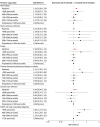Outcomes Among Patients Hospitalized With Non-COVID-19 Conditions Before and During the COVID-19 Pandemic in Alberta and Ontario, Canada
- PMID: 37436751
- PMCID: PMC10339156
- DOI: 10.1001/jamanetworkopen.2023.23035
Outcomes Among Patients Hospitalized With Non-COVID-19 Conditions Before and During the COVID-19 Pandemic in Alberta and Ontario, Canada
Abstract
Importance: The association of inpatient COVID-19 caseloads with outcomes in patients hospitalized with non-COVID-19 conditions is unclear.
Objective: To determine whether 30-day mortality and length of stay (LOS) for patients hospitalized with non-COVID-19 medical conditions differed (1) before and during the pandemic and (2) across COVID-19 caseloads.
Design, setting, and participants: This retrospective cohort study compared patient hospitalizations between April 1, 2018, and September 30, 2019 (prepandemic), vs between April 1, 2020, and September 30, 2021 (during the pandemic), in 235 acute care hospitals in Alberta and Ontario, Canada. All adults hospitalized for heart failure (HF), chronic obstructive pulmonary disease (COPD) or asthma, urinary tract infection or urosepsis, acute coronary syndrome, or stroke were included.
Exposure: The monthly surge index for each hospital from April 2020 through September 2021 was used as a measure of COVID-19 caseload relative to baseline bed capacity.
Main outcomes and measures: The primary study outcome was 30-day all-cause mortality after hospital admission for the 5 selected conditions or COVID-19 as measured by hierarchical multivariable regression models. Length of stay was the secondary outcome.
Results: Between April 2018 and September 2019, 132 240 patients (mean [SD] age, 71.8 [14.8] years; 61 493 female [46.5%] and 70 747 male [53.5%]) were hospitalized for the selected medical conditions as their most responsible diagnosis compared with 115 225 (mean [SD] age, 71.9 [14.7] years, 52 058 female [45.2%] and 63 167 male [54.8%]) between April 2020 and September 2021 (114 414 [99.3%] of whom had negative SARS-CoV-2 test results). Patients admitted during the pandemic with any of the selected conditions and concomitant SARS-CoV-2 infection exhibited a much longer LOS (mean [SD], 8.6 [7.1] days or a median of 6 days longer [range, 1-22 days]) and greater mortality (varying across diagnoses, but with a mean [SD] absolute increase at 30 days of 4.7% [3.1%]) than those without coinfection. Patients hospitalized with any of the selected conditions without concomitant SARS-CoV-2 infection had similar LOSs during the pandemic as before the pandemic, and only patients with HF (adjusted odds ratio [AOR], 1.16; 95% CI, 1.09-1.24) and COPD or asthma (AOR, 1.41; 95% CI, 1.30-1.53) had a higher risk-adjusted 30-day mortality during the pandemic. As hospitals experienced COVID-19 surges, LOS and risk-adjusted mortality remained stable for patients with the selected conditions but were higher in patients with COVID-19. Once capacity reached above the 99th percentile, patients' 30-day mortality AOR was 1.80 (95% CI, 1.24-2.61) vs when the surge index was below the 75th percentile.
Conclusions and relevance: This cohort study found that during surges in COVID-19 caseloads, mortality rates were significantly higher only for hospitalized patients with COVID-19. However, most patients hospitalized with non-COVID-19 conditions and negative SARS-CoV-2 test results (except those with HF or with COPD or asthma) exhibited similar risk-adjusted outcomes during the pandemic as before the pandemic, even during COVID-19 caseload surges, suggesting resiliency in the event of regional or hospital-specific occupancy strains.
Conflict of interest statement
Figures



References
Publication types
MeSH terms
Grants and funding
LinkOut - more resources
Full Text Sources
Medical
Research Materials
Miscellaneous

